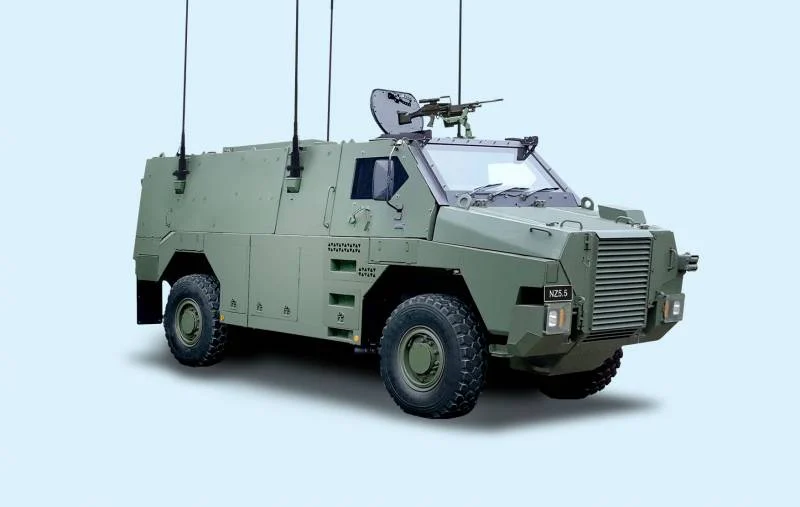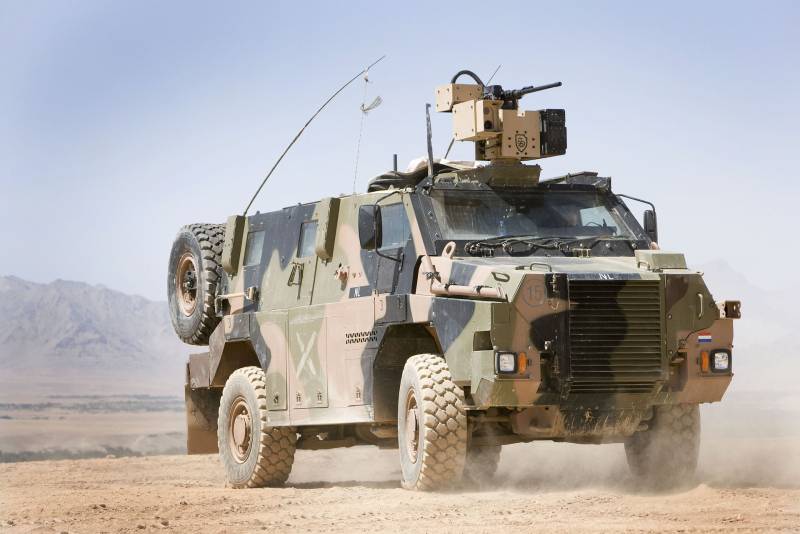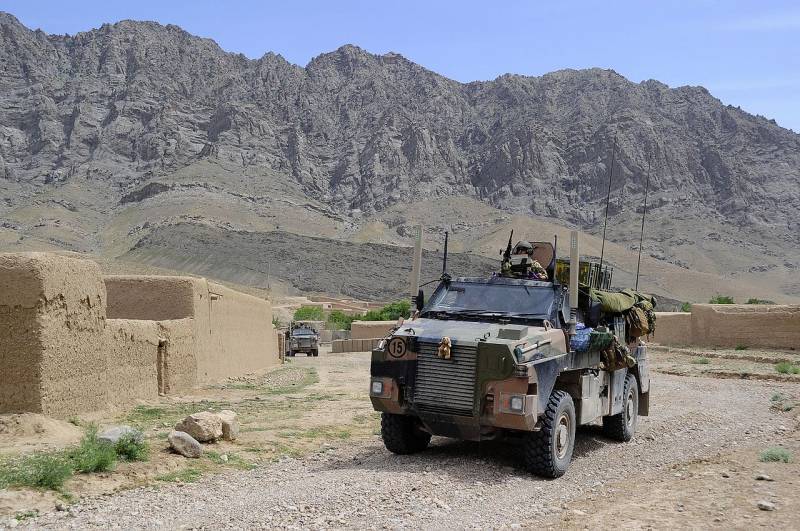Armored car from the country of kangaroo
Bushmaster armored vehicles with a 4x4 wheel arrangement are capable of carrying up to 10 paratroopers and are a fairly large armored vehicle. Fighting vehicles are manufactured by the defense company Thales Australia. The Bushmaster armored car turned out to be quite successful and found application not only in the Australian army. Buyers of this model were also found in the Old World (the Netherlands and Great Britain purchased the armored vehicles). And more recently, at the beginning of July 2020, the New Zealand army ordered a large batch of 43 armored vehicles.
The history of the armored car Bushmaster 4x4
The Bushmaster 4x4 armored vehicle was designed by specialists from the Australian defense corporation ADI, which today is the Australian branch of the multinational Thales. Thales Australia is responsible for the production of the armored vehicle. The new armored vehicle was developed in order to meet the Australian armed forces' own needs for a mobile infantry vehicle IMV (Infantry Mobility Vehicle, infantry vehicle). The preference for the local version of the armored vehicle was given within the framework of an international competition, which took place back in March 1991.
It is important to understand that, first of all, the Australian army needed a new combat vehicle designed to transport troops, cargo and equipment over long distances; it was not intended to be used in battles. Before the outbreak of hostilities, the infantry had to drop out of the vehicle. Since only light armor was provided for, the designation IMV was invented for the new armored vehicle to distinguish the armored car from the heavier armored personnel carriers: the tracked M113 or the wheeled ASLAV. However, it soon became clear that the use of high-strength steel provided the Bushmaster 4x4 with better ballistic protection than the M113's aluminum armor. At the same time, the new Australian armored car also received mine protection, so the designation of the vehicle was soon changed from IMV to PMV (Protected Mobility Vehicle, protected vehicle).
At the same time, the path to mass production was slow. A prototype of the new Australian armored vehicle was ready only in 1996, and a series of intensive tests of new military equipment took place only in 1998 as part of the Bushranger program. The competitors of the armored vehicles at this stage were ASLAV 8x8 and M-113A1. As a result, in March 2000, the project of the Australian Defense Industries company officially became the winner. At the same time, a contract was signed for the supply of the first 370 armored vehicles to the Australian army (the deal was $ 118 million).
The first 11 serial combat vehicles underwent a series of extensive military trials from mid-2003 to mid-2004. Mass serial production of the new Bushmaster 4x4 armored vehicle began in Australia only in 2005. Since then, Thales Australia has already assembled about 1200 armored vehicles, the vast majority of which are in service with the Australian army.
Technical features of the armored car Bushmaster
Today, Thales Australia offers its customers various models of the Bushmaster 4x4 armored vehicle: armored personnel carrier, command post vehicle, patrol vehicle, transport vehicle, carrier of various weapons systems, and protected medical vehicle. According to the manufacturer's assurances, a combat vehicle with a maximum weight of 15,4 tons is able to provide reliable protection for up to 10 passengers and combines reliable ballistic protection and explosion protection with good mobility and maneuverability. At the same time, the armored car is in service with various countries and has already managed to take part in local conflicts in recent years, having confirmed its effectiveness in combat conditions. The armored vehicle really saved the lives of the landing party.
Bushmaster armored vehicles were operated in the Middle East, Africa and the Pacific Ocean, having proven themselves in various climatic conditions and combat situations. A feature of the armored vehicle is a large armored all-welded hull with a volume of 11 cubic meters. The entire space is air-conditioned and accommodates up to 10 people, including the driver. The bottom of the armored car has a V-shape and reliably protects the troops from explosive devices: both standard mines and homemade land mines. According to the developers, the armored vehicle is capable of surviving an explosion of up to 9,5 kg in TNT equivalent without a threat to the life of the crew and the landing force. At the same time, the standard level of ballistic protection is limited to 7,62 mm caliber bullets, but can be enhanced at the request of the customer.
Despite the impressive weight (the combat weight of the armored car reaches 15,4 tons), the car turned out to be quite mobile and fast. This is largely due to the installation of a Caterpillar turbocharged diesel engine with a volume of 7,2 liters and a capacity of 300 hp. from. The engine has enough capabilities to provide the armored vehicle with a maximum speed of 100 km / h. At the same time, the cruising range on the highway reaches 800 km. In turn, the presence of an independent suspension, four-wheel drive and high ground clearance (470 mm) provide the Bushmaster 4x4 armored car with high cross-country ability on various terrain.
The maximum vehicle length is 7,18 meters, width - 2,48 meters, height - 2,65 meters. The dimensions of the armored car made it possible to equip it with a spacious hull with a large useful internal volume. The car was originally created for the conditions of Northern Australia, including a desert area, so it immediately received air conditioning. The internal volume and carrying capacity of up to 4 tons make it possible to ensure the autonomy of the landing of 9 people for up to three days, for such a period there is enough fuel, provisions and ammunition.

Bushmaster armored car after being blown up by an improvised explosive device
At the same time, the Bushmaster armored car is designed according to the scheme of conventional bonnet trucks. The armored vehicle has a front engine, behind it is the cockpit, followed by a compartment for the landing. An important feature is that the cockpit and the troop compartment are made in the same volume. Access to the armored car is through a door located in the aft armor plate of the hull. In addition, there are five hatches on the roof of the armored vehicle. A turret can be installed in front of the front hatch to accommodate a 7,62 mm or 12,7 mm heavy machine gun. It is possible to install remotely controlled weapon modules with machine-gun armament or a NATO-type 40-mm automatic grenade launcher instead of the turret. There is also the possibility of installing ATGM.
Contract for the supply of Bushmaster NZ5.5 to New Zealand
In early July 2020, it became known that the New Zealand Ministry of Defense had agreed with the country's government a contract for the purchase of a large batch of Australian-made Bushmaster armored vehicles. The New Zealand Army will receive 43 armored vehicles in a special version of the Bushmaster NZ5.5, a photo of which the military department presented on its social networks. In the New Zealand Army, armored vehicles are to replace the outdated Pinzgauer armored vehicles.
According to information published on the official website of the New Zealand government, the deal was worth NZ $ 102,9 million (approximately $ 67,14 million). In addition to the armored vehicles themselves, this amount takes into account the delivery, training and education of the New Zealand military, the supply of simulators, auxiliary equipment, as well as the modernization of infrastructure in the New Zealand military camp Linton. The latter is necessary for the maintenance of new armored vehicles. The delivery of armored vehicles is expected to begin at the end of 2022, and the entire order will be completed by the end of 2023.

Bushmaster NZ5.5 armored car for the New Zealand army, photo by the Ministry of Defense of New Zealand
In addition to direct combat operations, the New Zealand army expects to use the new armored vehicles for civilian purposes, for example, during disaster relief and emergency situations. Separately, the possibility of using Bushmaster NZ5.5 machines as protected medical vehicles, which are currently not in the New Zealand army, is highlighted. At the same time, New Zealand already has experience in operating Australian Bushmaster armored vehicles. The first five armored vehicles were purchased in 2018 and are used by the New Zealand Special Operations Forces.
It is worth noting that the Australian armored car has a good export potential. In addition to the immediate neighbor, this armored vehicle has already been purchased by Japan (8 vehicles), Indonesia (4 vehicles), Jamaica (18 vehicles), Fiji (10 vehicles). The largest foreign customers are the Netherlands (at least 98 armored vehicles in the army and marines) and Great Britain (24 vehicles). Thus, soon the third largest fleet of these armored vehicles will be in New Zealand - after Australia itself (1052 armored vehicles were transferred to the Australian military) and the Netherlands.



Information